
The Canadian Pacific Railway, also known simply as CPR or Canadian Pacific and formerly as CP Rail (1968–1996), was a Canadian Class I railway incorporated in 1881. The railway was owned by Canadian Pacific Railway Limited, which began operations as legal owner in a corporate restructuring in 2001.
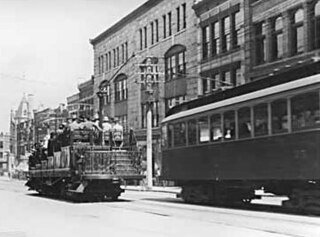
The British Columbia Electric Railway (BCER) was an historic railway which operated in southwestern British Columbia, Canada. Originally the parent company for, and later a division of, BC Electric Company, the BCER assumed control of existing streetcar and interurban lines in southwestern British Columbia in 1897, and operated the electric railway systems in the region until the last interurban service was discontinued in 1958. During and after the streetcar era, BC Electric also ran bus and trolleybus systems in Greater Vancouver and bus service in Greater Victoria; these systems subsequently became part of BC Transit, and the routes in Greater Vancouver eventually came under the control of TransLink. Trolley buses still run in the City of Vancouver with one line extending into Burnaby.

Rail transport in Ireland is provided by Iarnród Éireann in the Republic of Ireland and by Northern Ireland Railways in Northern Ireland.

Port Moody is a city in British Columbia, Canada, and a member municipality of the Metro Vancouver Regional District. It envelops the east end of Burrard Inlet and is the smallest of the Tri-Cities, bordered by Coquitlam on the east and south and by Burnaby on the west. The villages of Belcarra and Anmore, along with the rugged Coast Mountains, lie to the northwest and north, respectively. It is named for Richard Clement Moody, the first lieutenant governor of the Colony of British Columbia.

Pichi Richi Railway is a 39 kilometres narrow-gauge heritage railway in the southern Flinders Ranges of South Australia between Quorn and Port Augusta. For much of its length the line lies in the picturesque Pichi Richi Pass, where the line was completed in 1879 as work proceeded north to build a railway to the "Red Centre" of Australia – the Central Australia Railway.
Heritage Park Historical Village is a historical park in Calgary, Alberta, Canada, on 127 acres (51 ha) of parkland on the banks of the Glenmore Reservoir, in the city's southwestern quadrant. The Historical Village part of the park is open 7 days a week (10-5) from the Canadian May long weekend through to the September Labour Day long weekend, and then weekends from Labour Day through to Canadian Thanksgiving weekend in mid October. The Heritage Town Square is open year-round. As one of Canada's largest living history museums, it is one of the city's most visited tourist attractions. Exhibits span western Canadian history from the 1860s to the 1950s. Many of the buildings are historical and were transported to the park to be placed on display. Others are re-creations of actual buildings. Most of the structures are furnished and decorated with genuine artifacts. Staff dress in historic costume, and antique automobiles and horse-drawn vehicles service the site. Calgary Transit provides regular shuttle service from Heritage C-Train station. The park opened on July 1, 1964.
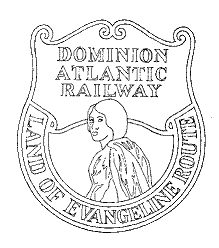
The Dominion Atlantic Railway was a historic railway which operated in the western part of Nova Scotia in Canada, primarily through an agricultural district known as the Annapolis Valley.

Rocky Point Park, also known as Rocky Point, is situated along Burrard Inlet in Port Moody, British Columbia, next to the PoMo Museum. It is 3.8 hectares in size, and is the most well-known park in Port Moody.

The Alberni Pacific Railway is a heritage railway originating in Port Alberni, British Columbia. Due to budget and equipment concerns, the railway did not operate in the 2020 season.
The South Simcoe Railway is a steam heritage railway in Tottenham, Ontario, north of Toronto. Operating excursions since 1992, it is the oldest operating steam heritage railway in Ontario and features the second oldest operating steam locomotive in Canada.
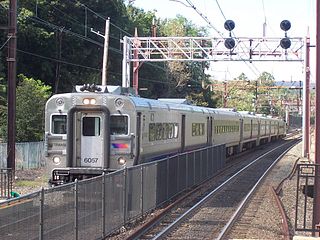
The Comet railcar is a class of locomotive-hauled railcars that was first designed in the late 1960s by Pullman-Standard as a modern commuter car for North American rail lines. Later, the Comet moniker was adopted by NJ Transit for all of its non-powered single level commuter coaches. Additional series of cars bearing the Comet name, based on the original design, have since been built by Bombardier Transportation and Alstom. The successful design was adopted by numerous commuter agencies.

Port Moody station was a stop on the West Coast Express commuter rail line connecting Vancouver to Mission, British Columbia, Canada. The station was located on the south side of the Canadian Pacific Railway (CPR) tracks in Port Moody, at the north foot of Williams Street, approximately 200 metres (660 ft) north of St. John's Street. The station opened in 1995, when the West Coast Express began operating. All services were operated by TransLink.

The 620/720 class railcars were a class of diesel multiple unit built by the New South Wales Government Railways and operated from 1961 until 2007.
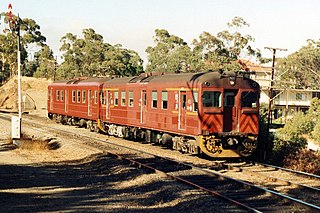
Redhen railcar was the nickname given to the 300 and 400 classes of diesel-hydraulic railcars designed and built by the South Australian Railways’ Islington Railway Workshops between 1955 and 1971. The class remained in service until 1996 and remain a nostalgic part of South Australian culture; some are operated by the SteamRanger Heritage Railway and other railway preservation entities.

The Winnipeg Railway Museum was a railway museum located on tracks 1 and 2 within the Via Rail-operated Union Station in Winnipeg, Manitoba, Canada. Volunteers from the Midwestern Rail Association Inc., a non-profit organization founded in 1975, operated the museum.

The GE 45-ton switcher is a 4-axle diesel locomotive built by General Electric between 1940 and 1956.

The National Railway Museum is the largest railway museum in Australia. More than 100 major exhibits, mainly from the South Australian Railways (SAR) and Commonwealth Railways and their successor, Australian National, are on display at its 3.5 hectares site in Port Adelaide, South Australia. The museum opened at Lipson Street in 1988 after 18 years at the SAR's former main locomotive depot at Mile End.
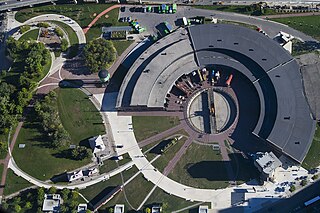
Roundhouse Park is a 17 acre park in the downtown core of Toronto, Ontario, Canada. It is in the former Railway Lands. It features the John Street Roundhouse, a preserved locomotive roundhouse which is home to the Toronto Railway Museum, Steam Whistle Brewing, and the restaurant and entertainment complex The Rec Room. The park is also home to a collection of trains, the former Canadian Pacific Railway Don Station, and the Roundhouse Park Miniature Railway. The park is bounded by Bremner Boulevard, Lower Simcoe Street, Lake Shore Boulevard West/Gardiner Expressway and Rees Street.

The NDH class railcars are a class of self propelled diesel-hydraulic railcars designed by Commonwealth Engineering and built by the Gloucester Railway Carriage & Wagon Company in England for the Commonwealth Railways, Australia in 1954. They were known as Gloucester railcars.

The Lake Erie and Northern Railway was an interurban electric railway which operated in the Grand River Valley in Ontario, Canada. The railway owned and operated a north–south mainline which ran from Galt in the north to Port Dover on the shore of Lake Erie in the south. Along the way, it ran through rural areas of Waterloo County, Brant County, and Norfolk County, as well as the city of Brantford, where it had an interchange with the Brantford and Hamilton Electric Railway. Construction on the mainline began in 1913. The railway began operations in 1916 as a subsidiary of the Canadian Pacific Railway (CPR), which had purchased the line before construction had finished. In 1931, it was consolidated with the Grand River Railway under a single CPR subsidiary, the Canadian Pacific Electric Lines (CPEL), which managed both interurban railways, though they continued to exist as legally separate entities. Passenger service was discontinued in 1955 but electric freight operations continued until 1961, when the LE&N's electric locomotives were replaced by diesel CPR locomotives and the line was de-electrified. In the same year, service on the mainline from Simcoe to Port Dover was discontinued, but the remainder continued to operate as a branchline which as early as 1975 was known as the CP Simcoe Subdivision. The remainder of the line was officially abandoned in the early 1990s, ending almost seventy-five years of operation.



















